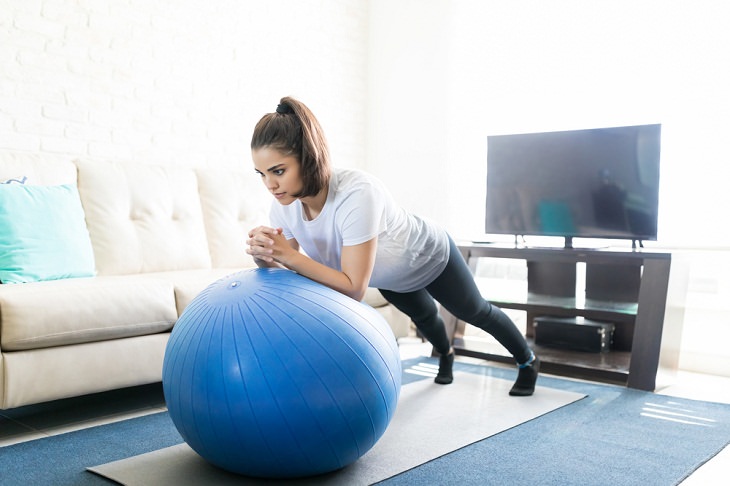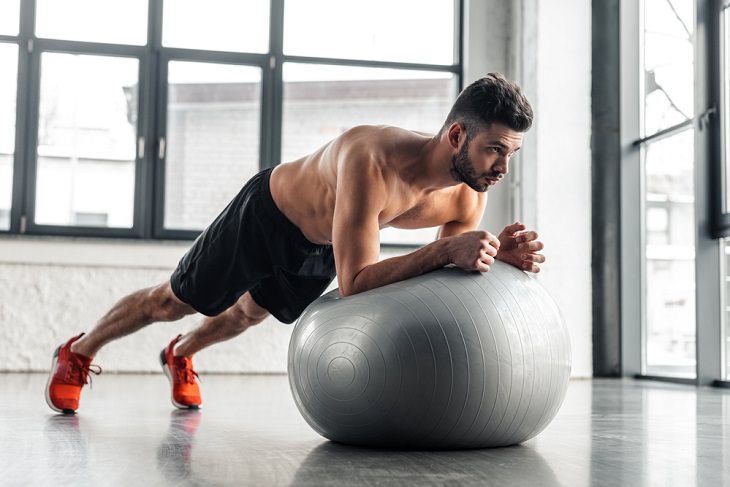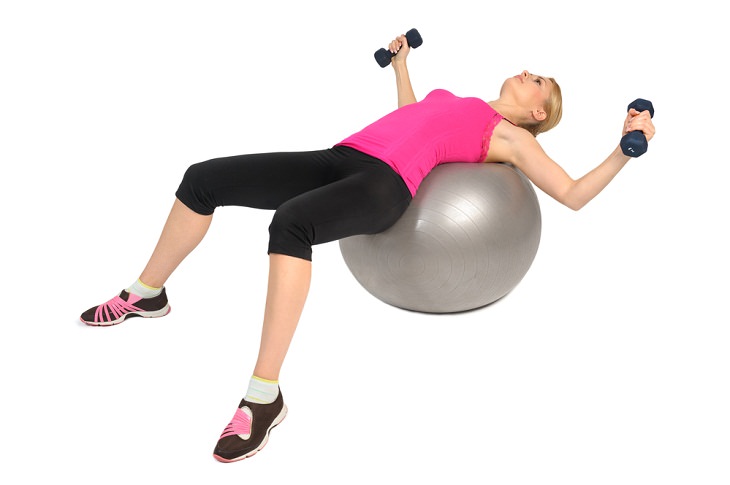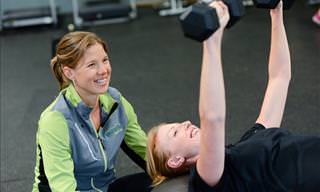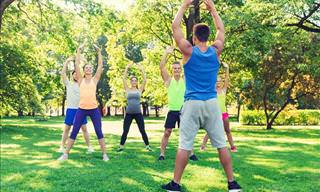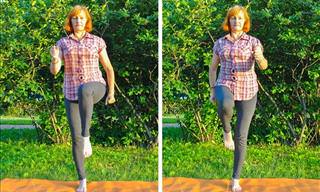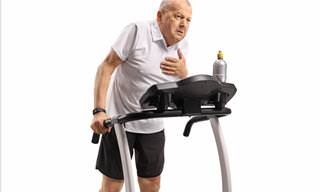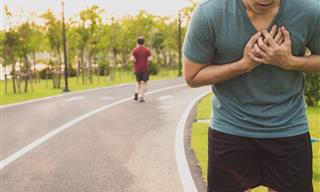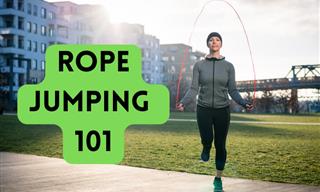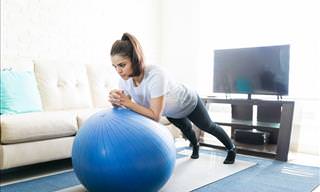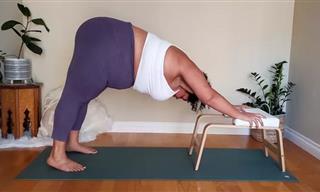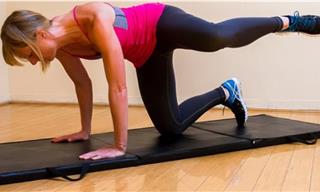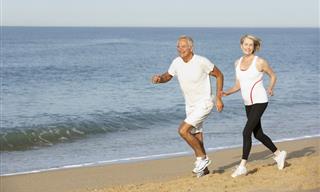Before you decide on getting one of these balls, however, you must know which is the right size for you. For example, people between 5 feet and 5.5 feet should choose a 55-centimeter ball. Those who are between 5'6 and 5'11 should opt for a 65-centimeter ball. Lastly, a 75-centimeter ball would be ideal for people between 6 feet and 6'3 in height.
Now, let's take a look at some common and easy stability ball workouts that will be beneficial for your whole body.
1. Single-Leg Bridge
Benefits: Increased posterior chain strength, improved proximal hip and core stability, and better hip dissociation.
Step 1: Lie faceup on the floor behind the ball with your knees bent. Place your feet on the ball and your arms on the floor by your sides. Now slowly raise your hips off the floor until your upper back is stabilized.
Step 2: Pause and then slowly raise one leg straight up. Lower the leg and then return to start. Repeat after 30 seconds and keep alternating the legs. Perform 2-3 sets on each side.
2. Incline plank
Benefits: Works on the abdominal muscles as well as the other ab muscles and the core muscles that run from the pelvis along the spine and up to the shoulder girdle.
Step 1: Place the stability ball on the floor and get into a pushup position with your hands on it. Rest your weight on your elbows on it.
Step 2: Hold your body in a straight line from head to heels. Make sure that your hips don’t sag. Maintain this position for at least 20-30 seconds. Do 3-5 sets and rest for 30 seconds after each set.
3. Wall Squats
Benefits: Works your quadriceps, gluteal muscles (a set of smaller muscles located in the buttocks), hamstrings, hip flexors, and core.
Step 1: Place the stability ball up against a wall and make sure it braces against your back. Now, lower down into a squat position until your legs form 90-degree angles at the knees.
Step 2: Use the ball to support your back and roll it from your lower back to your shoulder blades. Squat down low to deepen the move and provide more stability. Complete 10 to 15 reps (repetitions).
Note: Make sure that your knees don’t roll out to the sides during the exercise. They should be in line with the rest of your body.
4. Hamstring curl
Benefits: Works your gluteal muscles, hamstrings, and core.
Step 1: Lie on your back and put your calves and heels on the stability ball. Your arms should be on your sides and your palms should be facing down.
Step 2: Move your hips upward by squeezing your gluteal muscles and hamstrings until your body is straight. Engage your core and extend your legs straight out, moving the ball away from you. Slowly lift your hips and bend your knees.
Step 3: Roll the ball back in by pulling your heels towards your buttocks until the soles of your feet touch the ball. Now, stretch your knees and lower your hips and back to the floor. Repeat. Complete 12 to 15 reps.
5. Back Extension
Benefits: Strengthens the muscles of the lower back.
Step 1: Place the front of your body from hips to ribs on the ball. Your legs should be extended straight behind while your toes must rest on the floor. Your body should form one, long line.
Step 2: Raise your chest high and hold on to the ball for balance. Pull your shoulders back as you exhale and keep your neck in line with the spine. Return to a relaxed position. Complete 12–15 reps.
6. Push-ups
Benefits: Works your chest and shoulder muscles. Also helps activate a number of core muscles.
Step 1: Lie with your stomach on the stability ball with both feet and hands on the floor, hip- and shoulder-width apart. Place your hands on the ball at the sides of your chest and your toes on the floor with your legs straight. Now, push your body up until your arms are almost straight. Make sure that your elbows aren’t locked.
Step 2: Hold and balance for two seconds. Return to the starting position slowly and continue for 8–10 reps.
7. Chest press
Benefits: Works your shoulders and triceps. Strengthens both your chest and core muscles.
Step 1: Lie your back down on the ball while holding one dumbbell in each hand. Keep your feet flat on the floor with your ankles directly under your knees. Bring both weights up to meet your shoulders while bending your arms with your elbows out wide.
Step 2: Engage your core with your hips lifted. Exhale slowly as you press the weights toward the ceiling. Make sure that you are holding the dumbbells by your chest with your palms facing forward. Hold this position for a second.
Step 3: Lower the dumbbells back to the starting position slowly. Repeat while using your abs to keep your body still. Complete three sets of 10-12 reps keeping your hips lifted all through.
8. Mountain Climber
Benefits: Great cardio workout. Also works at your core.
Step 1: Begin by resting your hands on either side of the ball. Extend your feet out behind you in a way that you are leaning on the ball in a high plank position.
Step 2: With your core engaged, bring your right knee forward under your chest. Switch legs quickly, bringing the left knee forward while sending your right foot back. Return to the starting position. Complete 12 reps, alternating legs.
Share these exercises with your friends and family
 Go to BabaMail
Go to BabaMail


